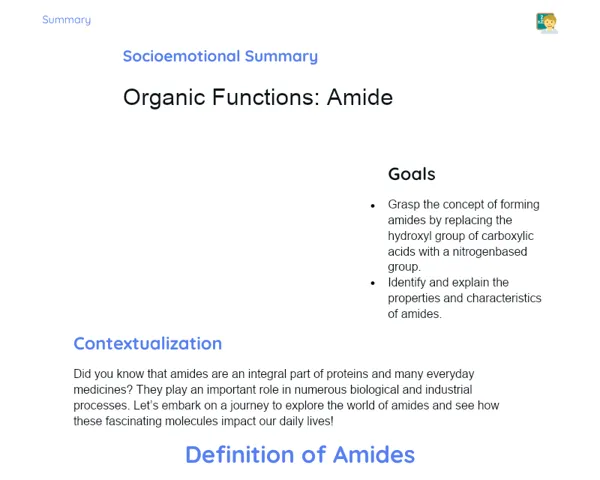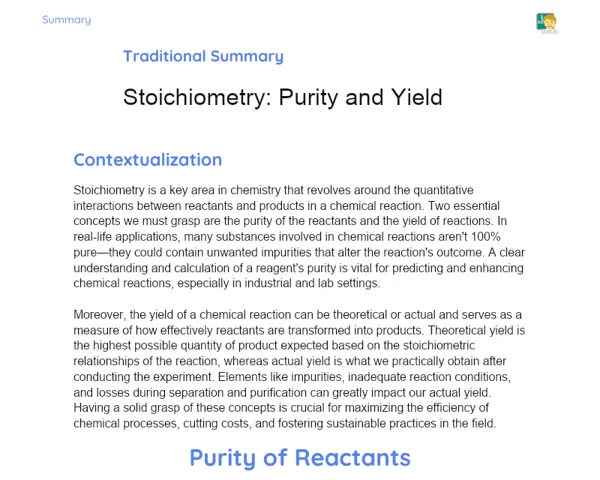Socioemotional Summary Conclusion
Goals
1. Understand how esters are formed through the reaction of carboxylic acids and alcohols.
2. Identify the properties and characteristics of esters.
Contextualization
Did you know that the delightful aroma of fresh fruits, like bananas and apples, is due to esters? These fascinating organic compounds are part of our everyday lives, from scrumptious dishes to enchanting fragrances. Esters, formed from the reaction between carboxylic acids and alcohols, not only deepen our understanding of chemistry but also enhance our appreciation for the finer details in our surroundings. Are you ready to dive into this captivating world of esters together?
Exercising Your Knowledge
Definition of Esters
Esters are organic compounds created from the reaction between carboxylic acids and alcohols, with the release of a water molecule. They are integral to many everyday applications, particularly in the flavours and fragrances we enjoy. The general formula for esters is R-COO-R', where R and R' denote alkyl or aryl groups.
-
Formation: Esters are produced when carboxylic acids react with alcohols, releasing water.
-
Structure: The general formula for esters is R-COO-R', where R and R' represent alkyl or aryl groups.
-
Applications: Esters are extensively used in the food and fragrance industries owing to their aromatic qualities.
Esterification Reaction
The esterification reaction is the process where a carboxylic acid combines with an alcohol to produce an ester and water, often in the presence of an acid catalyst like sulfuric acid. This reaction is crucial for the industrial production of many esters.
-
Reagents: Carboxylic acid and alcohol serve as the reagents in the esterification process.
-
Product: The resultant product of this reaction is an ester and water.
-
Catalyst: An acid catalyst, typically sulfuric acid, is needed to accelerate the reaction.
Nomenclature of Esters
To name an ester, we identify the alkoxy group (R') first, followed by the acid group (R-COO), using the suffix 'ate' along with the name of the alkoxy group. For instance, the ester generated from the reaction of acetic acid with ethanol is called ethyl acetate.
-
Identification of the Alkoxy Group: We name the alkoxy group (R') first.
-
Identification of the Acid Group: The acid group (R-COO) is named next.
-
Example: The ester formed from acetic acid and ethanol is referred to as ethyl acetate.
Key Terms
-
Esters: Organic compounds formed from the reaction between carboxylic acids and alcohols.
-
Esterification Reaction: The process of producing esters and water from the interaction of acids and alcohols.
-
Nomenclature: The system of naming esters based on the alkyl and acid groups involved.
For Reflection
-
How do esters in foods and fragrances impact your sensory and emotional experiences?
-
In what ways can an understanding of ester chemistry assist you in making informed choices in your daily life?
-
How does comprehension of the properties and uses of esters enhance your appreciation for chemistry and inspire you to explore this subject further?
Important Conclusions
-
We learned that esters are created through the reaction between carboxylic acids and alcohols, with the elimination of a water molecule.
-
We identified features of esters, such as their pleasant fragrances and volatility.
-
We understood ester nomenclature, where the alkoxy group is named first, followed by the acid group.
Impacts on Society
Esters significantly influence our daily lives. They are found in numerous consumer products, such as food, where they impart artificial flavours, and in perfumes, offering delightful scents. Gaining knowledge about the chemistry of esters enables us to appreciate these products better and make more prudent choices regarding our consumption.
Moreover, esters have essential emotional connections due to their role in perfumes and fragrances. A specific scent can trigger memories and emotions, illustrating how chemistry intertwines with our feelings and well-being. Being conscious of this can help us make more thoughtful emotional decisions regarding the products we use daily.
Dealing with Emotions
Let's engage in an exercise based on the RULER method to address our emotions when studying esters. First, take a moment to reflect quietly at home and recognize how you felt during the class about esters. Understand what caused that emotion: was it something difficult or perhaps intriguing? Name that emotion accurately, whether it's curiosity, confusion, or enthusiasm. Express that emotion by writing it down in a journal or discussing it with a friend or family member. Finally, regulate the emotion by identifying a positive way to manage it: this could involve reviewing the content, posing questions to your teacher, or seeking additional information from various sources.
Study Tips
-
Review the content regularly: Spend a few minutes each day revisiting what you've learned about esters, aiding in knowledge retention.
-
Connect with daily life: Try to spot esters in products you interact with daily, like perfumes or food items, to make your learning experience more relatable.
-
Study in groups: Share your questions and findings with classmates. Often, discussing the subject with others can provide fresh insights and facilitate better understanding.



